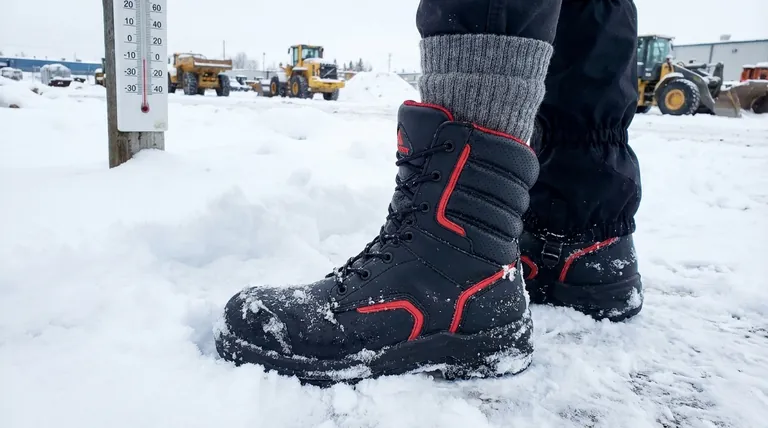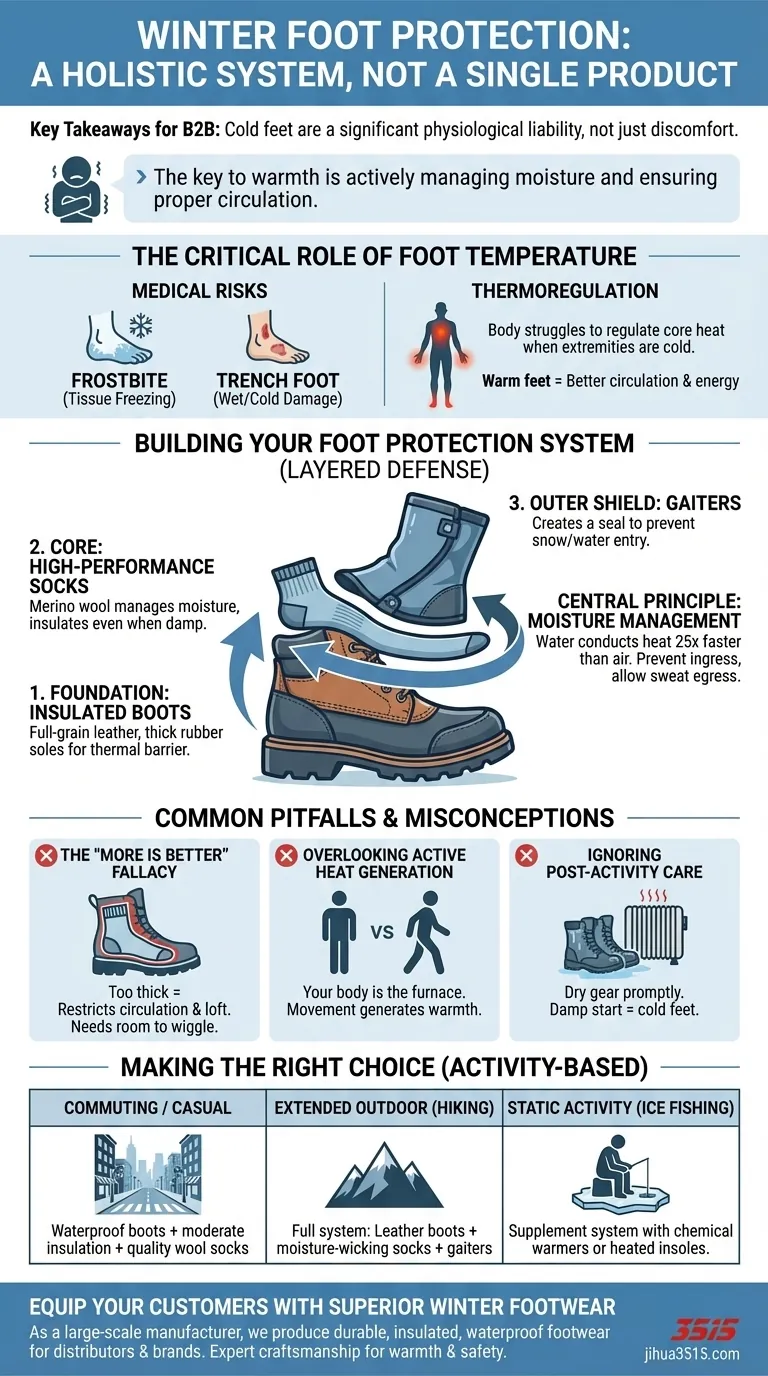Protecting your feet from the cold is a system, not a single product. The key takeaways involve combining insulated, waterproof footwear like full-grain leather boots with thick rubber soles, using high-performance socks to manage moisture, and adding accessories like gaiters for a complete seal. This integrated approach is essential for preventing dangerous heat loss and ensuring both safety and comfort in winter conditions.
Cold feet are more than a simple discomfort; they are a significant physiological liability. The key to warmth is not just adding insulation, but actively managing moisture and ensuring proper circulation, as wetness and restricted blood flow are the primary drivers of dangerous cold.

The Critical Role of Foot Temperature
Understanding why warm feet are essential is the first step toward effective protection. The impact extends far beyond immediate comfort, affecting your body's overall ability to function in cold environments.
Beyond Discomfort: The Medical Risks
When your feet get dangerously cold, your mobility can be impaired. This can lead to severe medical conditions like frostbite, where skin and tissues freeze, and trench foot, which is tissue damage caused by prolonged exposure to wet and cold conditions.
These conditions damage skin, nerves, and blood vessels, leading to numbness, swelling, and in serious cases, tissue death.
The Body's Thermoregulation System
Your body works hard to maintain a stable core temperature. If key extremities like your head, hands, or feet get cold, the entire system struggles to regulate heat effectively.
Keeping feet warm allows blood vessels to remain open, promoting better circulation that distributes heat throughout the body. This supports higher energy levels and can even bolster your immune system.
Building Your Foot Protection System
An effective strategy for warm feet relies on several components working together. Think of it as a layered defense designed to insulate, block moisture, and manage perspiration.
The Foundation: Insulated and Durable Footwear
The outer layer of your system is the boot itself. Materials like full-grain leather offer excellent durability and natural insulation, while thick rubber soles are critical for creating a thermal barrier between your feet and the frozen ground.
The Core Principle: Moisture Management
Wet feet are cold feet. Water conducts heat away from your body 25 times faster than air, making moisture management the single most important factor in staying warm.
This means preventing water from getting in (waterproofing) and allowing sweat to get out (breathability).
The Workhorse: High-Performance Socks
The right socks are non-negotiable. Wool socks, particularly merino wool, are the gold standard because they insulate effectively and continue to keep you warm even when they become damp.
They actively pull moisture away from your skin, which is crucial for keeping your feet dry from sweat.
The Outer Shield: Waterproofing and Gaiters
Ensure your boots are properly waterproofed. For deep snow or wet conditions, gaiters are an invaluable accessory. They are worn over the top of your boots and lower pants to create a seal that prevents snow, ice, and water from entering from above.
Common Pitfalls and Misconceptions
Many well-intentioned efforts to stay warm backfire due to common misunderstandings. Avoiding these mistakes is just as important as choosing the right gear.
The "More is Better" Fallacy
Stuffing your boots with two pairs of socks or one overly thick pair is a frequent mistake. This can compress the insulating loft of the sock and, more importantly, restrict blood circulation, which will make your feet colder, not warmer.
A proper fit with enough room to wiggle your toes is essential for blood flow.
Overlooking Active Heat Generation
Your gear only retains heat; your body is the furnace. If you are standing still for long periods, your feet will eventually get cold. Simple physical activity, like walking or wiggling your toes, increases blood flow and generates critical warmth.
Ignoring Your Gear Post-Activity
Your responsibility doesn't end when you come inside. Boots and socks that are damp from sweat or snow need to be dried promptly and thoroughly. Starting your next day with damp gear guarantees cold feet.
Making the Right Choice for Your Activity
Tailor your approach based on your specific needs and environment. There is no single solution that fits every winter scenario.
- If your primary focus is daily commuting or casual wear: Prioritize waterproof boots with moderate insulation and quality wool socks for a simple, effective combination.
- If your primary focus is extended outdoor activity (like hiking): Invest in a complete system including full-grain leather boots, moisture-wicking socks, and gaiters to prevent snow entry.
- If your primary focus is a static activity (like winter cycling or ice fishing): Supplement your system with active solutions like chemical foot warmers or heated insoles, as your body may not generate enough heat on its own.
A well-protected foundation ensures you can not only endure the winter but thrive in it.
Summary Table:
| Key Component | Function | Example |
|---|---|---|
| Insulated, Waterproof Boots | Creates a barrier against cold and moisture. | Full-grain leather boots with thick rubber soles. |
| High-Performance Socks | Manages moisture and insulates even when damp. | Merino wool socks. |
| Accessories (Gaiters) | Provides a complete seal against snow and water. | Gaiters worn over boots and pants. |
| Proper Fit & Activity | Ensures blood circulation and generates body heat. | Avoid tight boots; wiggle toes and walk. |
Ready to Equip Your Customers with Superior Winter Footwear?
As a large-scale manufacturer, 3515 produces a comprehensive range of durable, insulated, and waterproof footwear designed for the harshest winter conditions. Our production capabilities encompass all types of boots and shoes, perfect for distributors, brand owners, and bulk clients looking to offer their customers reliable protection against the cold.
We combine expert craftsmanship with high-performance materials to ensure warmth, safety, and comfort. Let us help you build a winning winter footwear line.
Contact us today to discuss your manufacturing needs and request a quote!
Visual Guide

Related Products
- Premium Wholesale Waterproof Safety Boots High Performance Protection for Industrial Markets
- Factory Direct Wholesale Rain Boots Durable Waterproof & Fully Customizable
- High Performance Fire-Retardant Waterproof Safety Boots
- Premium Flame-Retardant Waterproof Safety Boots and Shoes
- Wholesale Waterproof Tactical Boots Custom Suede & High-Traction Soles
People Also Ask
- How do safety shoes protect you? A Guide to Essential Footwear Safety Features
- Is there a downside to steel toe boots? Weighing Protection Against Daily Comfort
- What boots do they wear on oil rigs? Essential Safety Footwear for Harsh Conditions
- What is a safety-toe in a boot? Your Guide to Choosing the Right Protection
- What are some real-world examples of safety footwear preventing injuries? Protect Your Workforce Effectively



















